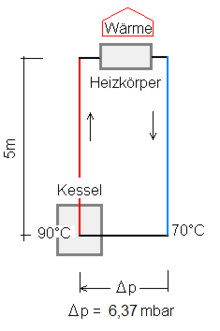Gravity heating
A gravity heating is a heating system whose circulation occurs solely through differences in the density of the water and the dependent buoyancy of the water in the risers. The system does not require a circulation pump .
function
In the flow line , the water has the flow temperature of the heating system and therefore has a low density, the water rises to the top. On the cold return side, the density is greater, the water is heavier and sinks to the bottom. This creates a circulation called gravity circulation , which circulates the heating water through the radiators , which are installed as high as possible . The pressure difference driving the circuit is roughly proportional to the height of the building (more precisely: the height of the heating network) and the difference in density between the supply and return water. Since the difference in density is only small due to the small typical temperature difference of approx. 20 K , the system reacts very slowly. In addition, if there is no hydraulic balancing (which was rarely done in the past), the last radiators in the circuit do not get hot enough.
application
Until the end of the 1960s (in the GDR until the mid-1980s) central heating systems were designed as gravity heating systems . These no longer meet today's comfort requirements, which is why they are being replaced by heating systems with circulation pumps.
disadvantage
- the low speeds require large nominal sizes, which in turn requires a large volume of water in the system.
- this means high material consumption, which is not compensated by the saved pump.
- at low water temperatures the circulation comes to a standstill.
- the low delivery differential pressure only allows a low flow resistance in the building heating network
- Provision of heating water at a defined temperature is not possible because the design is no downstream heating temperature control by means of a mixing valve allows
- the boiler must be installed at the lowest point in the heating network; roof-mounted central units are not possible
- If the heating water cools down in the ascending pipeline, it can sink into the storage tank and disturb the thermal water stratification there. In new boilers without gravity heating , a thermosiphon convection brake is installed as a countermeasure .
advantages
- no electrical power required for circulation, function even in the event of a power failure (provided the boiler does not have an electrical control)
- no ongoing follow-up costs
- almost noiseless
Sample calculation
Difference in static pressures at boiler level:
With:
- Differential pressure
- Acceleration due to gravity
- Temperature-dependent density of the heating medium in the return
- Temperature-dependent density of the heating medium in the flow
For a heater with a flow temperature of 90 ° C and a return temperature of 70 ° C, the densities are:
Used for h = 5 m:
For a system height of 5 m (middle of boiler to middle of radiator), a pressure of 6.37 mbar is available for the circulation of the heating water.
For each meter of the system height, the driving (effective) pressure difference is effective for 90 ° / 70 ° heating:
So that the circuit remains guaranteed, the flow resistance of the heating circuit belonging to the circuit must not exceed the driving pressure difference. This is achieved with relatively large pipe diameters and bulky ribbed radiators.
Conversion to pump operation
When the heat generator is renewed, the system is usually also converted to operate a pumped warm water system. For this purpose, the circulation pump with a gravity brake is installed on the one hand, and the expansion tank at the top of the system is taken out of service and a safety valve and a diaphragm expansion vessel are installed.
Special features for repairs and modifications
Due to the requirement for hydraulic balancing, presettable thermostatic valves are also required in gravity heating systems . Various manufacturers offer valve bodies with low pressure loss, as the usual high pressure loss across the thermostatic valve has a negative effect on heating operation.
Often, for smaller, time-limited repairs, pipelines are frozen in order to avoid emptying the system. Due to the high convection that is common in gravity systems, this often prevents the residual heat in the system for hours, as the freezers can only freeze stagnant water. This problem also applies to former systems that have been converted to pump operation.










